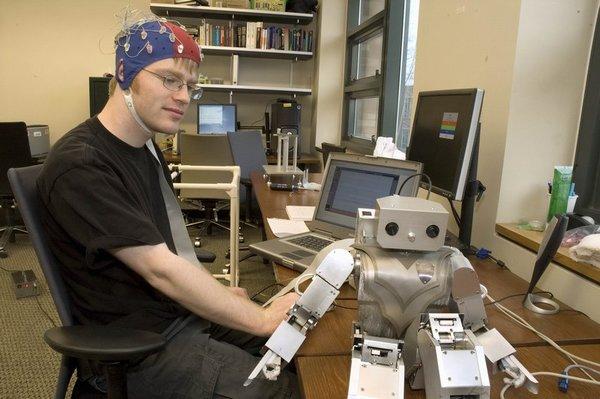UW Researchers Control the Movement of a Humanoid Robot with Signals from a Human Brain

A classic science-fiction scene shows a person wearing a metal skullcap with electrodes sticking out to detect the person’s thoughts. Another sci-fi movie standard depicts robots doing humans’ bidding. Now the two are combined, and in real life: University of Washington (UW) researchers in Seattle, WA can control the movement of a humanoid robot with signals from a human brain.
Rajesh Rao, associate professor of computer science and engineering, and his students have demonstrated that an individual can “order” a robot to move to specific locations and pick up specific objects merely by generating the proper brain waves that reflect the individual’s instructions. The results were presented recently at the Current Trends in Brain-Computer Interfacing meeting in Whistler, B.C.
“This is really a proof-of-concept demonstration,” Rao says. “It suggests that one day we might be able to use semi-autonomous robots for such jobs as helping disabled people or performing routine tasks in a person’s home.”
The controlling individual — in this case a graduate student in Rao’s lab — wears a cap dotted with 32 electrodes. The electrodes pick up brain signals from the scalp based on a technique called electroencephalography. The person watches the robot’s movements on a computer screen via two cameras, one mounted on the robot and another above it.
Right now, the “thought commands” are limited to a few basic instructions. A person can instruct the robot to move forward, choose one of two available objects, pick it up, and bring it to one of two locations. Preliminary results show 94 percent accuracy in choosing the correct object.
Objects available to be picked up are seen by the robot’s camera and conveyed to the user’s computer screen. Each object lights up randomly. When the person looks at the object that he or she wants to pick up and sees it suddenly brighten, the brain registers surprise. The computer detects this characteristic surprised pattern of brain activity and conveys the choice back to the robot, which then proceeds to pick up the selected object. A similar procedure is used to determine the user’s choice of a destination once the object has been picked up.
Click here for the entire story.



